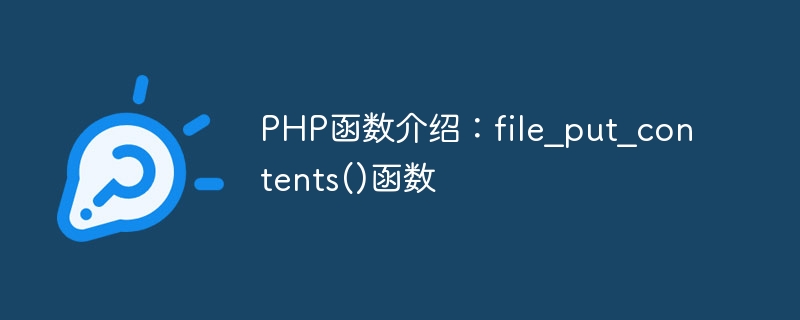Home >Backend Development >PHP Tutorial >PHP function introduction: file_put_contents() function
PHP function introduction: file_put_contents() function
- WBOYWBOYWBOYWBOYWBOYWBOYWBOYWBOYWBOYWBOYWBOYWBOYWBOriginal
- 2023-11-03 13:10:581902browse

PHP function introduction: file_put_contents() function
In PHP development, processing files is a very common task. Among them, the file_put_contents() function is very practical when operating files. It allows us to write to a file in a simple and efficient way without having to open and close the file individually.
The syntax of the file_put_contents() function is as follows:
file_put_contents(string $filename, mixed $data, int $flags = 0, resource $context = null): false|int
Parameter description:
-
$filename: The target file name to write the content to ; -
$data: The data to be written to the file can be a string, an array, or a callback function that returns a string; -
$flags: Optional parameter used to specify additional options for file writing. The default value is 0, indicating no additional options; -
$context: Optional parameter, used to specify the context for file writing, which is a resource type containing a resource handle.
Return value description:
- If the writing is successful, the number of bytes written will be returned;
- If the writing fails, false will be returned .
Below we will further introduce the use of the file_put_contents() function through some specific code examples.
-
Write string content to the file:
$filename = 'test.txt'; $data = 'Hello, world!'; file_put_contents($filename, $data);
The above code will create a file named test.txt in the current directory and replace the string " Hello, world!" is written to the file.
-
Append string content to the file:
$filename = 'test.txt'; $data = 'Hello, world again!'; file_put_contents($filename, $data, FILE_APPEND);
The above code uses the
FILE_APPENDoption to append the string "Hello, world again!" into the test.txt file. -
Write the array content to the file:
$filename = 'test.txt'; $data = ['apple', 'banana', 'orange']; file_put_contents($filename, implode(" ", $data));The above code will connect the array elements with newlines and write them to the test.txt file.
In addition to writing strings and arrays directly, we can also use callback functions to dynamically generate content to be written. For example, we can write the current time to a file:
$filename = 'test.txt';
$data = function(){
return date('Y-m-d H:i:s');
};
file_put_contents($filename, $data());In the above code, we use an anonymous function to return a string of the current time, and use the return value of this function as the content to be written.
When using the file_put_contents() function, we can also use it in combination with other functions, such as:
- Use
fopen()to open the file, and then usefwrite()Write the content, and finally usefclose()to close the file; - Use
file_get_contents()to read the file content, and then usefile_put_contents()Write new content.
Summary:
The file_put_contents() function is a very convenient file operation function in PHP, which can simplify the file writing process. It provides flexible parameter options and can handle different types of data such as strings, arrays, and callback functions. Whether writing new content or appending content, this function can be easily implemented. In actual development, reasonable use of the file_put_contents() function can reduce the amount of code and improve the efficiency of writing files.
The above is the detailed content of PHP function introduction: file_put_contents() function. For more information, please follow other related articles on the PHP Chinese website!
Related articles
See more- How do images in HTML adapt to the screen? This article has an introduction to the adaptive usage of images.
- What is a pseudo-class selector in css? A brief introduction to pseudo-class selectors
- Introduction to artificial intelligence algorithms
- What is the difference between php functions and methods?
- Introduction to Pyzmq

